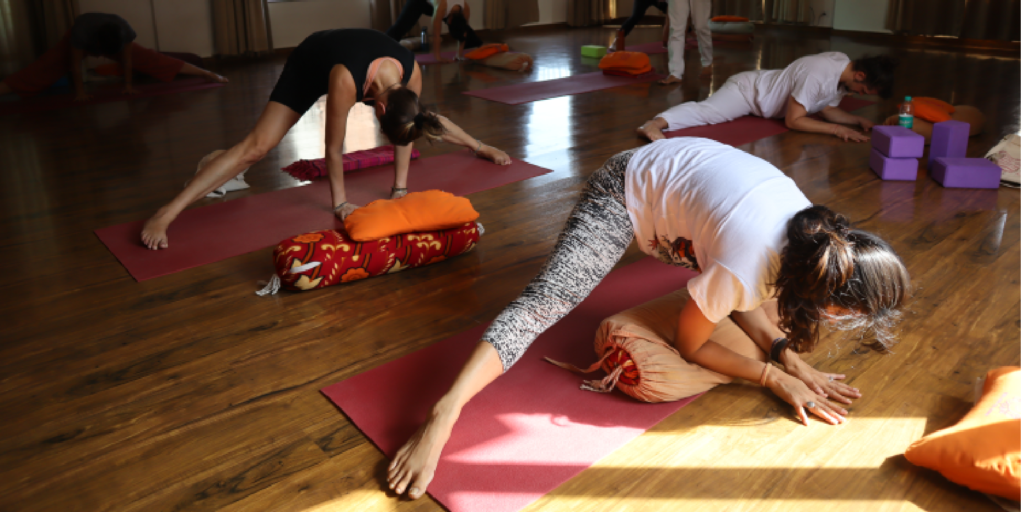This Yoga For Beginners Series is geared towards the absolute yoga beginner. There are many reasons yoga poses may be difficult for you:
- Inflexibility
- Muscle Weakness
- Inability To Balance
- Inability To Concentrate
This series will aim to work all areas of the body keeping these four reasons in mind. Remember, yoga is a lifelong practice. As a beginner, do not expect to do any yoga pose quickly. Just keep practicing regularly and enjoy each pose in whatever modified version you can do today.
What is Flexibility?
“Flexibility is the joint’s ability to attain its full range of motion.”
Each joint has a different range of motion. For example, in most people the wrist cannot bend much beyond a 90 degree angle. However, a flexible person can bend their knees to a 0 degree angle or even further, as in Hero’s Pose.

Flexibility is both inherited and influenced by our activity. One may be naturally inflexible in certain joints, however by practicing stretching exercises such as yoga, flexibility can be increased. Although it is important to note that every body has its own personal limits. So comparing your flexibility to another person’s is fruitless.
What Causes Inflexibility?
Inflexibility can be caused by many factors. Let’s take a look at a few:
1. Genetics
Some people are simply born more flexible than others. Although it is very possible to increase flexibility, just as it is possible for flexibility to deteriorate with age and inactivity.
2. Age Combined With Inactivity
As our bodies grow and age, the joints will lose flexibility if they are not regularly used and the muscles regularly stretched. As we age, our bodies dehydrate slightly which can cause the joints to stiffen. Additionally, aging brings increases in calcium deposits, changes in chemical tissue structure, and the reduction in muscle fiber will lead to inflexibility. However, if regular stretching and exercise is practiced, this process can be slowed dramatically.
3. Previous Injuries
If previous injuries were sustained to a joint or muscle, inflexibility may occur in that joint. This is because scarred muscle tissue can become less elastic.
How Can We Increase Flexibility?
It’s very important for your overall health to maintain flexibility. Flexible joints reduce the chance of injury and allow the body to exercise without pain or discomfort. Additionally, a tight muscle or joint can cause pain because other joints must make up for the tight joint’s limited range of motion.

So how can we increase flexibility? Practicing yoga is one of the best ways! Nearly all yoga poses involve stretching of the muscles. It is for this reason that yoga can be difficult for many people. But the only way increase flexibility is by gently stretching regularly.
It is important to avoid overstretching any muscle. Pain is a good indication that you have stretched to far. Overstretching will damage the muscle, causing scar tissue and therefore reducing flexibility in the long run. So always be careful when practicing yoga or any other type of stretching exercise. Go SLOW and be gentle with your muscles.
Yoga Poses to Improve Flexibility
Here are a few beginner-friendly yoga poses that can help improve flexibility:
1. Cat-Cow Pose (Marjaryasana-Bitilasana)
Benefits: Stretches the back and neck, warms up the spine
How to Do: Start on your hands and knees in a tabletop position. Inhale as you drop your belly towards the mat, lifting your chin and chest (Cow Pose). Exhale as you draw your belly to your spine and round your back towards the ceiling (Cat Pose).
2. Downward-Facing Dog (Adho Mukha Svanasana)
Benefits: Stretches the hamstrings, calves, and shoulders
How to Do: Start on your hands and knees. Lift your hips up and back, straightening your legs and arms to form an inverted V shape. Keep your heels slightly off the ground.
3. Standing Forward Bend (Uttanasana)
Benefits: Stretches the hamstrings, calves, and lower back
How to Do: Stand with your feet hip-width apart. Hinge at the hips and fold forward, bringing your chest towards your thighs. Let your head hang and grab opposite elbows or let your hands rest on the floor.
4. Butterfly Pose (Baddha Konasana)
Benefits: Stretches the inner thighs, groins, and knees
How to Do: Sit on the floor with your legs extended. Bend your knees and bring the soles of your feet together, letting your knees drop out to the sides. Hold your feet with your hands and sit up tall.
5. Child’s Pose (Balasana)
Benefits: Stretches the hips, thighs, and ankles; relaxes the body

How to Do: Kneel on the floor, touch your big toes together, and sit on your heels. Separate your knees hip-width apart, then fold forward, extending your arms in front of you or alongside your body.
Conclusion
Flexibility is essential for overall health and well-being. By understanding the factors that influence flexibility and practicing yoga regularly, you can improve your range of motion and reduce the risk of injury. Remember to practice gently and patiently, listening to your body to avoid overstretching. With consistent practice, you’ll see gradual improvements in your flexibility and overall physical condition. Enhance your practice and knowledge by joining a 200 hour Yoga Teacher Training in Rishikesh, where you can deepen your understanding of yoga and its benefits under the guidance of experienced instructors.




